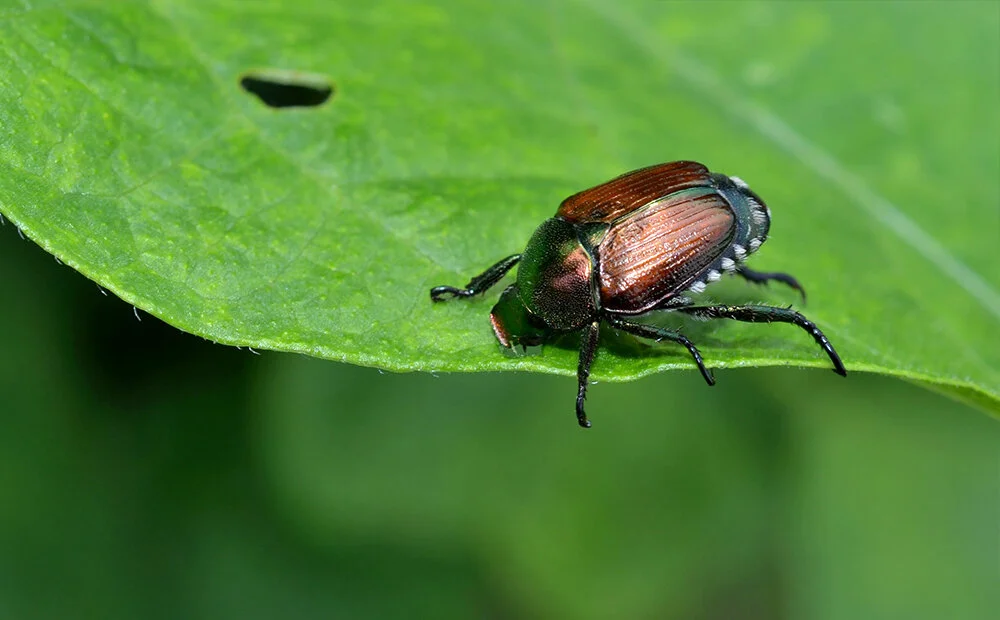FIGHTING JAPANESE BEETLES
We pour a lot of heart and soul into our gardens, and we’re proud of the beautiful backyard spaces that we create. It can be absolutely heartbreaking to see all of our hard work disappear in front of our eyes. Pests can act fast and wreak havoc on our favorite plants, and we never truly know when they’ll strike.
There are lots of pest control methods that are effective against nasty pest invaders without being too tough on our plants. However, there’s also a short (but growing) list of pests that are resistant to every method in the book. The Japanese beetle is one of these pests.
JAPANESE BEETLES IN THE GARDEN
As implied by their name, the Japanese beetle didn’t always call Indianapolis home. These pests travelled here from Japan by stowing away in tourists’ luggage, and they’ve been causing problems ever since. Because the adults don’t have any natural predators in the United States, they can often strike quickly and easily get out of hand.
The beetles themselves are quite easy to identify, with bright green metallic heads and copper bodies. However, the easier way to find them is their telltale damage patterns. The adults devour leaves and petals from the outside in, leaving only the plant veins behind. This is not only unsightly but also damaging to your plants. Although the larvae don’t pose too much of a risk to your plants, they are so attractive to burrowing animals they cause them to dig up your garden.
WHY JAPANESE BEETLES ARE SUCH A PROBLEM
Japanese beetles, like most pests, can cause lots of problems in your garden, but the real issue with them is that they are remarkably resistant to pesticides. Their shells are really thick and tough, shielding them from nearly any chemical that you could try. Even the ones that have been proven to work are so toxic that they have essentially been pulled from the shelves.
The real solution for Japanese beetles requires outsmarting them. Here’s how you can use some non-chemical solutions to keep your garden safe.
TACKLING THE BEETLE PROBLEM
While their thick shell can protect them from many things, they aren’t impervious to everything. Out-maneuvering these pests just requires a little cunning.
Japanese Beetle Traps are a popular option for defence against bugs worldwide. They use a cocktail of pheromones and scents to draw the beetles in. With the promise of food or a mate, they’re drawn into a container that they can’t get out of. Placing these traps around the perimeter of your property will entrap foraging beetles before they get out of hand in your garden. Emptying them and maintaining them regularly will keep them working effectively to trap Japanese beetles.
Beneficial nematodes are a popular option for controlling the life cycle of the Japanese beetles. Nematodes are microscopic parasites that infect and kill the beetle larvae in the soil, but they’re safe for you and your pets. Only certain species of nematodes are effective against Japanese beetles.
Neem Oil is a great alternative to pesticides, as it makes its way into their food and poisons their eggs and larvae. While its a safer alternative for most pets and children, keep it away from ponds as it might be damaging to aquatic life.
Hand pick the beetles from your plants to keep their numbers in check. Thankfully they are quite visible and vibrant so they are quick to spot. Simply pluck them off your plants. While this might be the more laborious option, it’s safe for your garden and is a sure way to work around their tough shells.
Japanese beetles can be the source of a lot of stress in the garden, as many of our traditional tools can be useless against them. But as tough as they are, you’re tougher! With the right supplies, you can still make quick work of this pesky pests.





